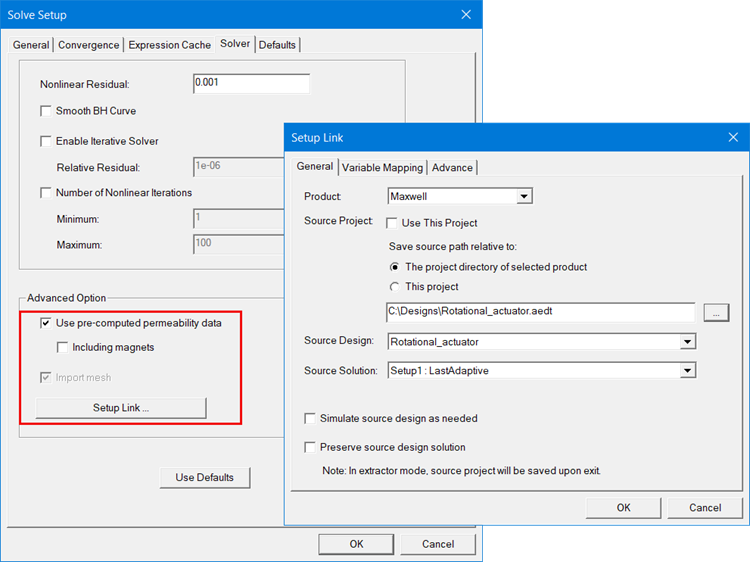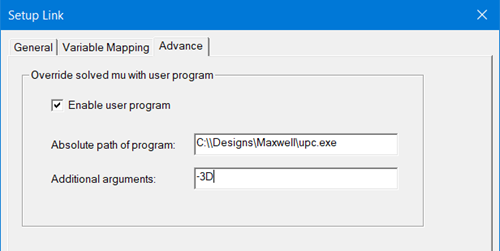Using the Advanced Permeability Option
The nonlinear characteristics of many magnetic materials are too complex to be defined through the definition of a B-H Curve. This feature enhances the existing permeability link by enabling the permeability characteristic of the target design to be obtained by mathematical manipulation of the permeability from the source design. The nonlinear “apparent” permeability from the source design is frozen (linearized) and used by the target design. Because the permeability in the target design is linear, the apparent and the incremental permeabilities will be identical and the apparent and incremental inductances will also match.
This manipulation is done via a user-supplied control program. A user-specified executable is launched at the beginning of target design simulation and the linked permeability data (i.e., the “frozen” mu) from the source design is overridden by the values calculated by the user control program. The target design solver is then launched and uses the overridden value in its calculation.
The user control executable program is launched with two file names as arguments:
- Per mesh element permeability value. This is the solved mu (i.e., the apparent permeability not the incremental permeability) from the source design. Note that the format of this file is different between 2D and 3D designs.
- Per mesh element information. Information
includes the centroid location (x, y, z), Bx, By, Bz at the centroid
and Hx, Hy, Hz at the centroid. The format of this file is the same between
2D and 3D designs.
Note: Refer to Advanced Permeability Option File Formats for information on these file formats.
Considerations for Using this Feature
-
To set up the advanced user control program option for permeability, select Setup Link on the Solver tab to open the Setup Link dialog.

- Specify the Source Design on the General tab.
-
On the Advance tab, select the check box Enable user program and provide the absolute path to the executable, and provide any Additional arguments needed by the user program.

- Simulate the target design.
Simulation of the source design will be automatically started if it is not already simulated. The user-supplied executable is launched. Additional information is logged in Setup>Profile regarding the launch of user executable.
- Simulation of the target design continues after user executable exits.
Note the following:
- Field post processing of target design will use the user-overridden mu.
- Editing boundary/excitation setup in the target design invalidates the current solution in target design.
- Linked data remains valid when boundary/excitation is changed. On next simulation of the target design, the prior user-overridden permeability will be used.
- Edit of the link setup (this includes the path to the user control program), or “removing” the user control program will invalidate the current solution and also the cached linked data. On the next simulation of the target design, the “frozen” permeability will be extracted again from the source design. If the link setup has opted to enable the user control program, the currently designated user program will be launched. If the link setup has opted not to override the linked data, the extracted mu from the source design will be used as is.
- Clear Linked Data in the target design invalidates the current solution and cached linked data in the target design.
- On the next simulation of the target design, the frozen permeability will be extracted again from the source design. The user executable will be launched to allow the permeability to be overridden.
- Editing the source design has no effect on the existing solution in the target design. Users need to Clear Linked Data in target design if a new simulation in the target design is desired.
- After the simulation of the target design, the user-overridden mu becomes part of the solution of the target design and this target design can then be used as the source of another design.
